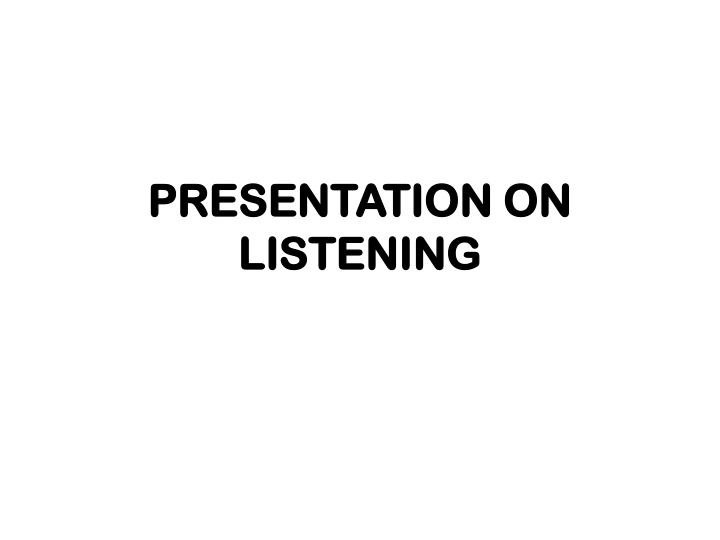



PRESENT ESENTATION TION ON N LIS ISTENING TENING
DISTRIBUTION OF COMMUNICATION ACTIVITIES WRITING (least used, most taught) 9% TALKING (next READING (next most used, next least used, next least taught) most taught0 30% 16% LISTENING (most use, least taught) 45%
LISTENING L= V + VE+ NVC Meaning ??
LISTENING L= V + VE Meaning ??
LISTENING L= NVC Meaning ??
LISTENING FOLLOWS A LAW L= A X W 2 Where A = Physical Psychological W= Willingness
Negative Listening 1. Pseudo Listening 2. Selective Listening 3. Passive listening 4. Insulated listening 5. Defensive listening 6. Ambush listening
Stages of Listening • Hearing and Sensing. • Attending. • Comprehending and Interpreting. • Responding. • Communicating and Using.
Kinds of Listening • Appreciate- Listening for aesthetic enjoyment of sound. • Active - Listening as a willing act of attending to and interpreting with an open mind the words and feelings a speaker expresses. • Comprehensive – listening to learn. • Critical – listening in order to make decisions such as when one listens to a political debate. • Defensive - Listening to discover arguments for oneself and against a speaker.
Kinds of Listening Dichotic- Listening to two things at once. Discriminative- listening in order to distinguish the significance of one sound from another. Empathic/Empathetic- listening to put yourself in another person’s place to understand, but not necessarily agree with what’s being said and why. Reflective/Responsive- Listening to paraphase, summarize, and clarify a message. Selective- Listening only to what one wants to hear. Therapeutic- Listening to help someone talk through a problem.
Kinds of Listeners Analytical : • Tend towards perfectionism and deal in logic and details. • Keep feelings to themselves. • Prepare your case in advance and be accurate and realistic. • Provide tangible evidence to support your points. Amiable: • Put a high values on people and friendships. • They go out of their way not to offend. • Have opinions, but are not inclined to tell . • Ask “how” questions to draw their opinions.
Kinds of Listeners • Drivers : • Can appear to be pushy • making demands on themselves and others. • keep emotions under wraps • Resent those who gossip and waste in idle conversation. • Are decisive • Results oriented • Give guidance to those who need it and those who don’t as well. How to deal with them : • Be brief, specific, and to the point when dealing with drivers .
Kinds of Listeners Expressive : • Enthusiastic, creative, and intuitive. • Little tolerance for those unlike themselves. • Easily bored, they tend to go off on tangents. • Stick with the big picture when relating to this type.
THANK YOU
Recommend
More recommend